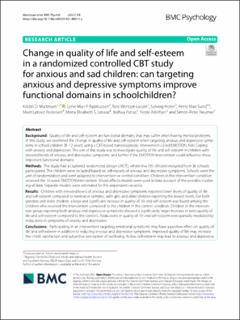| dc.contributor.author | Martinsen, Kristin | |
| dc.contributor.author | Rasmussen, Lene-Mari Potulski | |
| dc.contributor.author | Wentzel-Larsen, Tore | |
| dc.contributor.author | Holen, Solveig | |
| dc.contributor.author | Sund, Anne Mari | |
| dc.contributor.author | Pedersen, Marit Løtveit | |
| dc.contributor.author | Løvaas, Mona Elisabeth S | |
| dc.contributor.author | Patras, Joshua | |
| dc.contributor.author | Adolfsen, Frode | |
| dc.contributor.author | Neumer, Simon-Peter | |
| dc.date.accessioned | 2022-03-25T13:41:36Z | |
| dc.date.available | 2022-03-25T13:41:36Z | |
| dc.date.created | 2021-04-28T13:36:14Z | |
| dc.date.issued | 2021 | |
| dc.identifier.citation | BMC Psychology. 2021, 9:8 1-14. | |
| dc.identifier.issn | 2050-7283 | |
| dc.identifier.uri | https://hdl.handle.net/11250/2987696 | |
| dc.description.abstract | Background: Quality of life and self-esteem are functional domains that may suffer when having mental problems. In this study, we examined the change in quality of life and self-esteem when targeting anxious and depressive symptoms in school children (8–12 years) using a CBT-based transdiagnostic intervention called EMOTION, Kids Coping with anxiety and depression. The aim of this study was to investigate quality of life and self-esteem in children with elevated levels of anxious and depressive symptoms, and further if the EMOTION intervention could influence these important functional domains. Methods: The study had a clustered randomized design (cRCT), where N = 795 children recruited from 36 schools participated. The children were included based on self-reports of anxious and depressive symptoms. Schools were the unit of randomization and were assigned to intervention or control condition. Children in the intervention condition received the 10-week EMOTION intervention. Mixed effects models were used to take account of the possible clustering of data. Separate models were estimated for the dependent variables. Results: Children with elevated levels of anxious and depressive symptoms reported lower levels of quality of life and self-esteem compared to normative samples, with girls and older children reporting the lowest levels. For both genders and older children, a large and significant increase in quality of life and self-esteem was found among the children who received the intervention compared to the children in the control condition. Children in the intervention group reporting both anxious and depressive symptoms showed a significantly larger increase in both quality of life and self-esteem compared to the controls. Reductions in quality of life and self-esteem were partially mediated by reductions in symptoms of anxiety and depression. Conclusions: Participating in an intervention targeting emotional symptoms may have a positive effect on quality of life and self-esteem in addition to reducing anxious and depressive symptoms. Improved quality of life may increase the child’s satisfaction and subjective perception of wellbeing. As low self-esteem may lead to anxious and depressive symptoms, improving this functional domain in children may make them more robust dealing with future emotional challenges. Trial registration NCT02340637, retrospectively registered | |
| dc.language.iso | eng | |
| dc.title | Change in quality of life and self-esteem in a randomized controlled CBT study for anxious and sad children: can targeting anxious and depressive symptoms improve functional domains in schoolchildren? | |
| dc.type | Peer reviewed | |
| dc.type | Journal article | |
| dc.description.version | publishedVersion | |
| dc.source.pagenumber | 1-14 | |
| dc.source.volume | 9:8 | |
| dc.source.journal | BMC Psychology | |
| dc.identifier.doi | 10.1186/s40359-021-00511-y | |
| dc.identifier.cristin | 1906975 | |
| cristin.ispublished | true | |
| cristin.fulltext | original | |
| cristin.qualitycode | 1 | |
